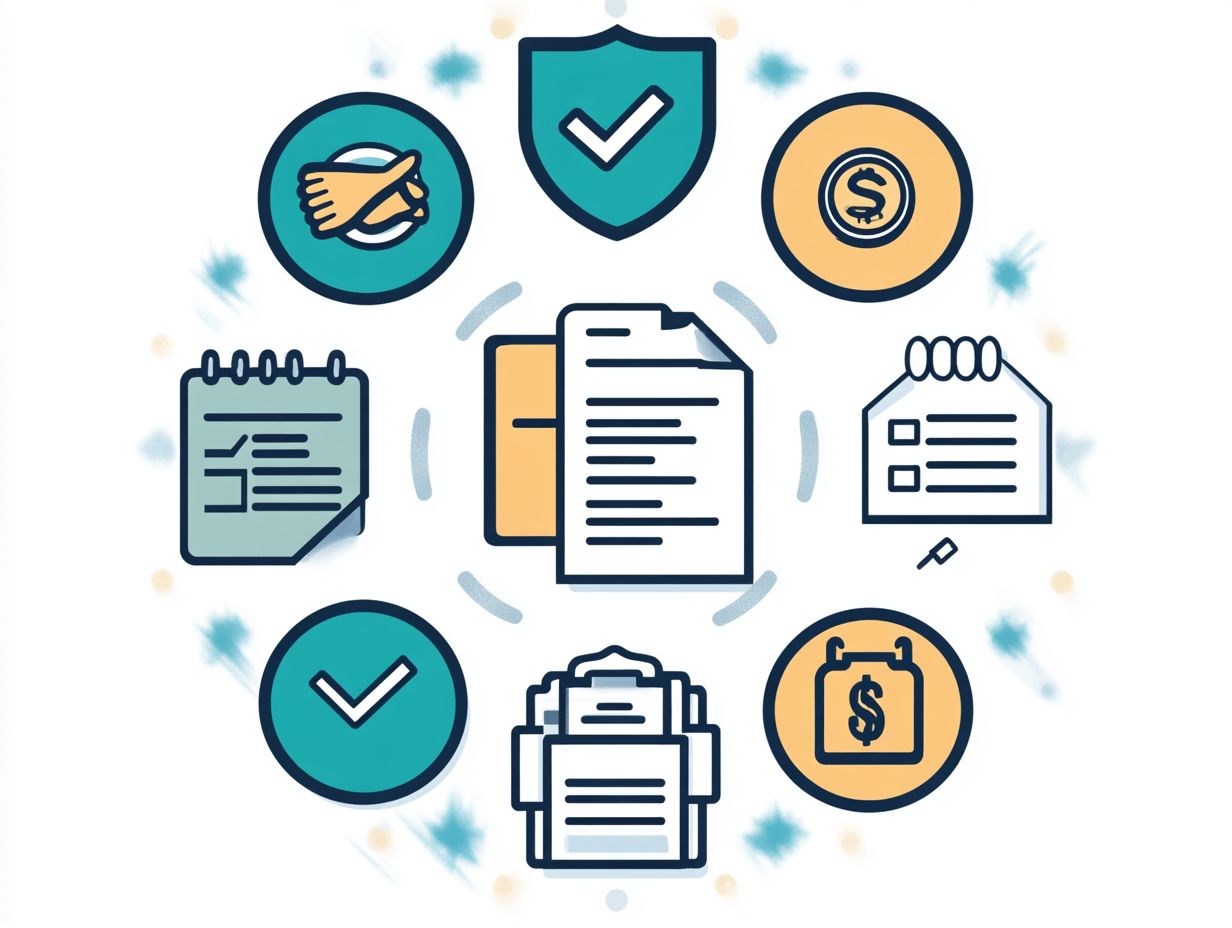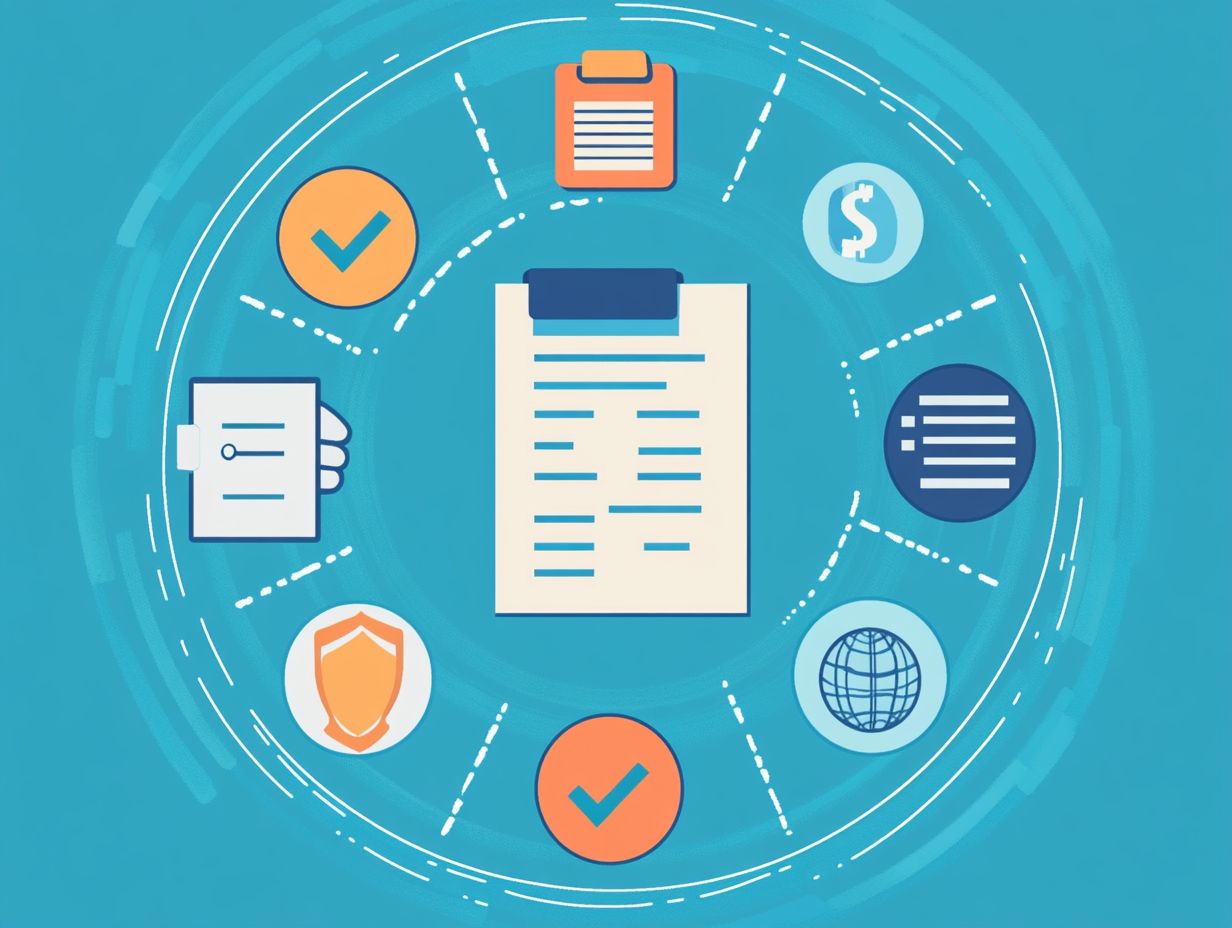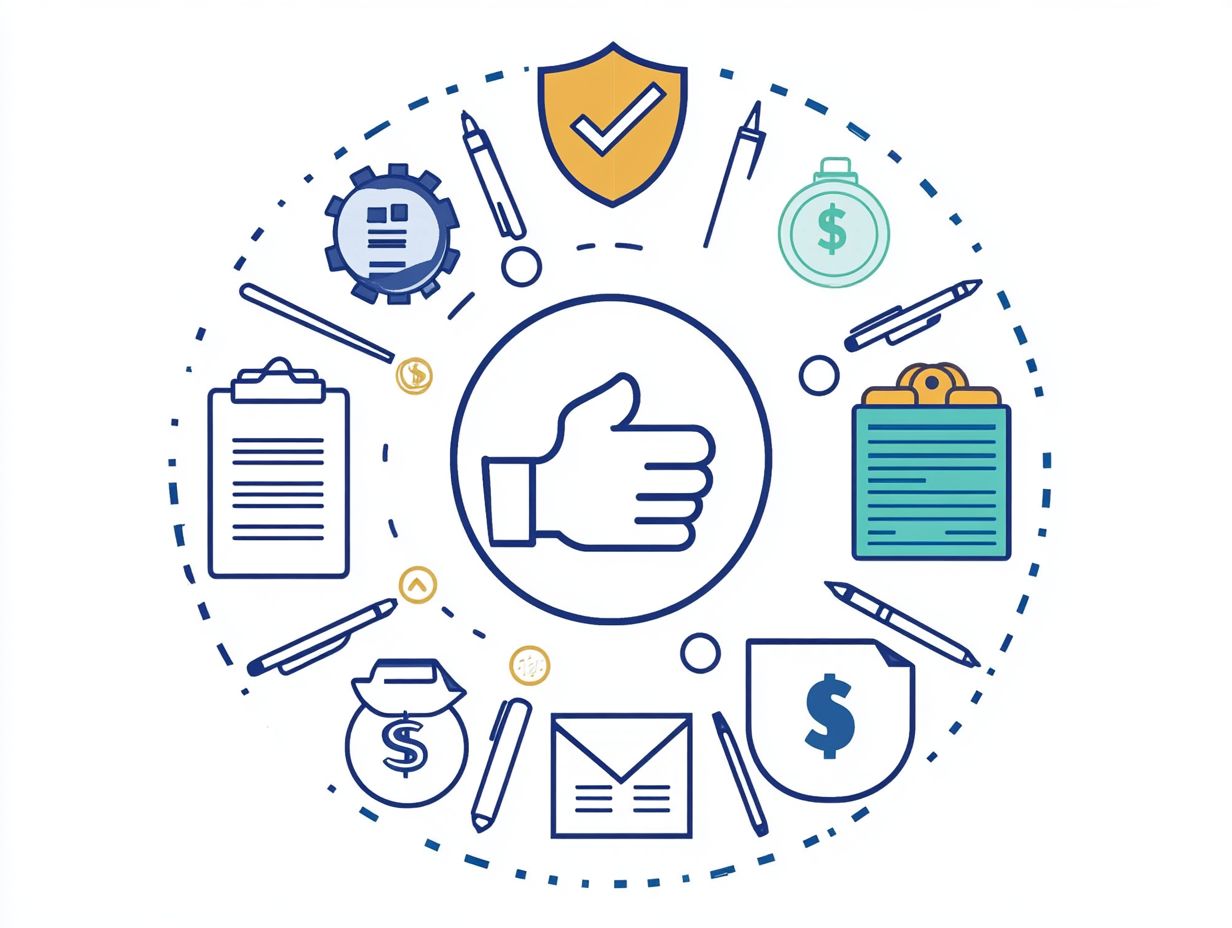10 Key Elements of Effective Licensing Agreements
Licensing agreements are essential in business. They let you use intellectual property while protecting your interests.
Understanding the key elements of a strong licensing agreement is vital. This article highlights ten important components, from identifying the parties to establishing payment terms.
Whether you re negotiating a new deal or revisiting an old one, mastering these elements gives you the confidence to navigate licensing complexities.
Contents
- Key Takeaways:
- 1. Clear Identification of Parties Involved
- 2. Detailed Description of Licensed Product or Service
- 3. Scope of License
- 4. Duration and Termination Clause
- 5. Payment Terms and Royalties
- 6. Intellectual Property Ownership and Protection
- 7. Quality Control and Performance Standards
- 8. Marketing and Distribution Rights
- 9. Confidentiality and Non-Disclosure Clauses
- 10. Dispute Resolution Mechanisms
- What Are Some Common Mistakes to Avoid in Licensing Agreements?
- What Are Some Key Considerations When Negotiating a Licensing Agreement?
- How Can a Business Determine If a Licensing Agreement Is Beneficial for Them?
- What Are the Different Types of Licensing Agreements?
- How Can a Business Ensure Compliance with a Licensing Agreement?
- What Are the Advantages and Disadvantages of Licensing Agreements?
- Frequently Asked Questions
- What are the 10 key elements of effective licensing agreements?
- Why is it important to have a clearly defined licensed property in a licensing agreement?
- What is the significance of the license scope in a licensing agreement?
- How does the license term impact a licensing agreement?
- What role does quality control play in a licensing agreement?
- What happens if a breach of the licensing agreement occurs?
Key Takeaways:

Clearly identifying all parties involved avoids confusion and legal disputes. You should include detailed descriptions of the licensed product or service for clarity. Properly defining the license’s scope, including limitations, helps prevent misunderstandings and potential breaches.
1. Clear Identification of Parties Involved
In any licensing agreement, you must clearly identify the parties. This establishes a strong foundation for effective business relationships, as highlighted in the 5 key takeaways from successful licensing agreements.
Such clarity helps enforce intellectual property rights and reduces the risk of legal disputes.
The owner of the intellectual property grants the user permission to utilize those creations under specified conditions. If either party is misidentified, confusion may arise over who holds the rights or owes obligations.
This confusion can lead to costly legal battles about ownership or misunderstandings regarding performance expectations. Such pitfalls jeopardize the agreement’s integrity and can tarnish business reputations, leading to a loss of valuable resources.
2. Detailed Description of Licensed Product or Service
A detailed description of the licensed product or service is crucial in a licensing agreement. It precisely defines the license’s scope and addresses potential trademark, patent, and copyright issues. For entrepreneurs, understanding 5 licensing agreement strategies can be invaluable.
Without clear specifications, misunderstandings can easily arise about software functionalities or product complexities. For instance, if your software application includes additional modules, failing to describe these can lead to disputes about what the license covers.
If a product’s design involves unique aesthetics, a vague outline could invite legal challenges about intellectual property rights. Such ambiguities strain professional relationships and may lead to costly litigation.
3. Scope of License
Defining the scope of a license in a licensing contract is crucial. It determines whether the agreement is exclusive or non-exclusive, significantly impacting the user’s rights and the legal protection of the intellectual property involved.
Different types of licensing agreements, like sole, exclusive, and non-exclusive, come with unique rights and obligations that shape the relationship between the owner and the user.
An exclusive license gives the user full rights to use the intellectual property, preventing the owner from granting those same rights to others. In contrast, a non-exclusive license allows the owner to share those rights with multiple parties.
By clearly defining the licensing scope, you position your business to gain a competitive edge while minimizing risks related to intellectual property infringement. This clarity fosters a more secure and profitable business environment.
4. Duration and Termination Clause
A well-defined duration and termination clause in licensing agreements is essential for establishing clear expectations between you and the other party. It outlines the length of the contract and the specific conditions under which either party can terminate the agreement. This helps avoid possible legal problems.
By clearly outlining these elements, you protect your interests and promote a collaborative atmosphere. Without a precise timeline and specific circumstances related to termination, confusion can ensue, leading to misunderstandings and costly legal challenges.
A vague termination clause creates ambiguity, leaving one party feeling unfairly treated if the agreement is abruptly dissolved. Clarity provided by a well-drafted clause allows both sides to anticipate their rights and responsibilities. This makes operations smoother and facilitates a more amicable resolution of any issues that may arise.
5. Payment Terms and Royalties
Establishing clear payment terms and royalties in licensing agreements is crucial for ensuring that all parties grasp the financial implications of the intellectual property involved. Exploring creative ways to structure licensing agreements can directly influence revenue generation and overall business success.
Incorporating structured payment frameworks allows you to outline upfront fees for initial financial security, ongoing royalties that reflect the continuous value generated, and performance-based compensation that ties rewards to the success of your product or service.
This thoughtful design clarifies expectations and minimizes the risk of disputes. Ignoring established payment terms can lead to serious legal consequences, with potential litigation resulting in costly settlements or damages.
Both sides must remain vigilant in upholding their obligations to cultivate a healthy, profitable partnership.
6. Intellectual Property Ownership and Protection

Clearly defining intellectual property ownership and protection in licensing agreements is essential for both the party granting the license and the party receiving it. Doing so establishes ownership rights and ensures that your intellectual property is legally shielded from unauthorized use, infringement, or misappropriation.
In the world of intellectual property patents, copyrights, and trademarks each category plays a vital role in protecting your inventive ideas, creative works, and brand identities. Patents act as a fortress for your innovative inventions, granting you exclusive rights that can inspire further advancements. Copyrights safeguard your artistic expressions, ensuring you receive recognition and compensation for your creative efforts. Meanwhile, trademarks distinguish your brand, fostering customer loyalty and trust.
By articulating ownership rights clearly in licensing agreements, you can steer clear of possible legal problems that might arise from misunderstandings or ambiguous terms. Understanding the common licensing agreement terms not only secures your valuable assets but also contributes to the overall integrity of the industry.
7. Quality Control and Performance Standards
In licensing agreements, establishing quality control and performance standards is crucial for maintaining product integrity. This ensures that the licensed product meets consumer expectations and adheres to the standards set by the licensor.
This approach protects the brand and nurtures strong business relationships. By incorporating specific quality control measures into your licensing contracts, you can outline expectations for product performance, manufacturing processes, and adherence to safety regulations.
This strategy is essential for protecting your brand and ensuring quality. Regular performance evaluations enable you to ensure compliance and provide necessary feedback.
Neglecting to enforce these standards risks damaging your brand image and facing potential legal repercussions or loss of intellectual property rights. Therefore, consistent monitoring is essential for upholding high standards and safeguarding your valuable assets.
8. Marketing and Distribution Rights
Outlining marketing and distribution rights in licensing agreements is essential for maximizing your competitive advantage. This clarity defines how your licensed product will be promoted and sold, ultimately influencing your revenue.
Clearly defining these channels helps create stronger partnerships. This ensures all parties align on their promotional strategies and sales efforts.
Employing various strategies such as localized marketing campaigns or joint promotions can lead to sustainable growth. This allows you to adapt to diverse consumer preferences and changing market conditions.
Ultimately, specifying these rights streamlines your operations and fosters long-term relationships built on mutual success.
9. Confidentiality and Non-Disclosure Clauses
In licensing agreements, confidentiality obligations and non-disclosure clauses are vital for protecting sensitive information and trade secrets. They ensure that you and your partner uphold your commitments to legal protection and maintain the integrity of the intellectual property at stake.
These provisions are essential not only for preserving your competitive edge but also for building trust with partners. For instance, you may need to protect proprietary information such as marketing strategies, customer lists, or technological innovations.
Breaching confidentiality can have severe repercussions, potentially leading to financial losses, tarnished reputations, and legal disputes. In some cases, such violations could even result in revoked licenses or hefty penalties.
Clearly defined non-disclosure agreements serve as crucial tools to address these risks. They affirm each party’s responsibilities and provide a framework for recourse should any issues arise.
10. Dispute Resolution Mechanisms
Incorporating effective dispute resolution mechanisms in your licensing agreements is essential for addressing potential conflicts. This provides clear pathways for resolving legal disputes while minimizing costly legal proceedings.
Methods such as arbitration and mediation offer valuable alternatives that can streamline the resolution process. By including these mechanisms, you save time and resources and foster a collaborative atmosphere, crucial for nurturing long-term partnerships.
Arbitration involves a neutral party making binding decisions, while mediation encourages open dialogue aimed at mutual agreement. These approaches enhance contract enforcement by ensuring clarity about obligations and dispute resolution processes.
By taking this proactive strategy, you pave the way for stronger business relationships built on trust and transparency.
What Are Some Common Mistakes to Avoid in Licensing Agreements?
Avoiding common pitfalls in licensing agreements is essential for both licensors and licensees. This helps mitigate the risks tied to legal disputes, exorbitant legal fees, and ineffective contract enforcement. Following the 5 best practices for drafting licensing agreements could prevent issues that might jeopardize your business relationships and intellectual property rights.
A comprehensive agreement clarifies terms and sets a solid framework for your obligations and rights, preventing misunderstandings before they occur.
Consider this: vague terms can lead to wildly different interpretations. For example, what you see as ‘reasonable efforts’ in a promotion clause might not align with how the other party views it.
To enhance clarity, define key terms and outline each party s specific responsibilities. Without robust dispute resolution mechanisms, you risk dragging out legal battles that could drain resources.
To counter this, think about incorporating alternative dispute resolution methods like mediation or arbitration. This method lets you tackle conflicts head-on and keep your relationships strong!
What Are Some Key Considerations When Negotiating a Licensing Agreement?

When negotiating a licensing agreement, consider various strategies to protect both parties’ interests. For example, reviewing the 5 key considerations for copyright licensing fosters successful partnerships and secures the necessary legal protection for the intellectual property involved.
Effective negotiation is not just about discussing compensation. It s about establishing agreements that reflect the value of the intellectual property while clarifying rights for usage and distribution. Legal protections are crucial, as they safeguard the contributions of both parties.
Good communication is vital. It helps you express your needs clearly and understand the other party. Listen actively and value everyone s goals to find common ground for a win-win outcome.
How Can a Business Determine If a Licensing Agreement Is Beneficial for Them?
As a business owner, determining whether a licensing agreement is beneficial requires careful evaluation of factors like competitive advantage, potential market reach, and revenue generation opportunities through partnerships.
Navigating the complex landscape of commerce requires a careful plan. Scrutinize the financial projections tied to the agreement such as anticipated revenue streams and costs and perform a comprehensive market analysis to understand competitive dynamics and consumer demand.
Make sure your long-term goals match up with the licensing deal. This alignment ensures it supports your broader vision for growth and innovation. For example, if you re a tech firm licensing software to educational institutions, you can instantly boost your visibility in the market while generating steady income expanding your product’s applicability across different sectors.
What Are the Different Types of Licensing Agreements?
Understanding the various types of licensing agreements like exclusive licensing, non-exclusive licensing, and different forms of intellectual property licensing is crucial for making informed decisions that align with your strategic goals.
Each type has unique characteristics that can significantly impact your revenue streams and market reach. Exclusive licensing grants a single entity the rights to use intellectual property, enhancing focus and investment, but it may limit broader market access.
Conversely, non-exclusive agreements allow multiple parties to benefit from the same intellectual property, fostering competition and possibly increasing profits for you as the original owner.
You can tailor these agreements by incorporating specific terms or conditions, such as geographical restrictions or duration limits, to ensure they align with your overall objectives and maximize your competitive edge.
How Can a Business Ensure Compliance with a Licensing Agreement?
To ensure compliance with a licensing agreement, establish clear guidelines regarding confidentiality obligations, adhere to specified contract terms, and implement effective monitoring mechanisms. Understanding the essential clauses in licensing agreements can help mitigate breach risks and ensure legal protection.
This includes conducting regular audits to evaluate compliance levels systematically, allowing you to identify potential issues before they escalate. Consistent communication with licensees is essential. Foster open dialogue to address concerns promptly and reinforce the importance of adhering to the contract.
Training sessions can enhance understanding of specific obligations, equipping employees and stakeholders with the resources to comply effectively. Access to clear documentation and ongoing support enables everyone involved to navigate the complexities of the agreement with confidence.
What Are the Advantages and Disadvantages of Licensing Agreements?
Licensing agreements have both benefits and drawbacks. They can boost your revenue and provide a competitive edge. However, they also come with risks, such as legal disputes and loss of control over creations like brands or inventions.
Think of these agreements as powerful tools for generating income. They allow you to enter new markets and expand your reach. By using established brands or innovations, you can drive growth and gain access to resources and expertise that might otherwise be out of reach.
Managing these agreements effectively is crucial one mistake could cost you dearly! Stay informed about your rights and conduct careful research to mitigate risks. This way, you can create an arrangement that benefits both parties and helps achieve business goals.
Frequently Asked Questions
What are the 10 key elements of effective licensing agreements?

The 10 key elements of effective licensing agreements are:
- Licensed property
- License scope
- License term
- License fee
- Payments
- Intellectual property rights
- Quality control
- Termination
- Indemnification
- Governing law and jurisdiction
Why is it important to have a clearly defined licensed property in a licensing agreement?
The licensed property refers to the specific product, technology, or creation being licensed. Clear definitions prevent misunderstandings between the licensor and licensee, ensuring both parties know what is being licensed. This clarity helps avoid disputes in the future.
What is the significance of the license scope in a licensing agreement?
The license scope outlines how the licensee can use the licensed property. A well-defined scope prevents unauthorized use, which can lead to legal issues. It also protects the licensor’s rights by ensuring the licensee doesn’t exceed agreed-upon uses.
How does the license term impact a licensing agreement?
The license term specifies how long the licensee can use the licensed property. This is essential as it sets the timeline for usage and any payments. A longer term may involve higher fees, while a shorter term might require renewals and negotiations on terms.
What role does quality control play in a licensing agreement?
Quality control allows the licensor to monitor the quality of the licensed property. This is crucial for protecting the licensor’s brand and reputation. Quality control provisions ensure that the licensee meets required standards, keeping the product consistent for consumers.
What happens if a breach of the licensing agreement occurs?
If a breach occurs, the termination clause allows either party to end the agreement. This clause specifies reasons for termination and necessary steps. A well-defined termination clause is vital for protecting both parties’ interests in case of a breach.






